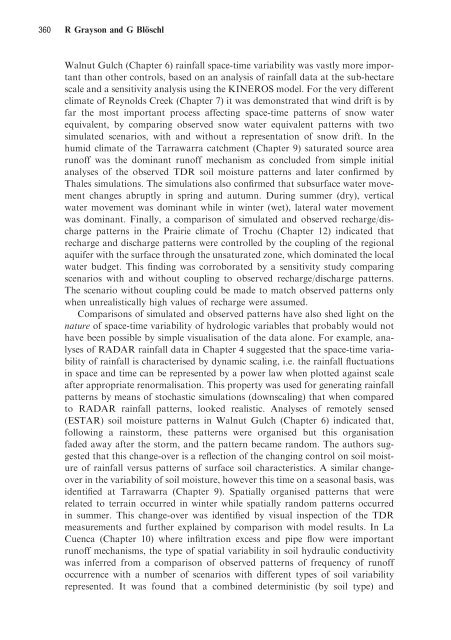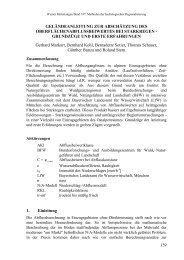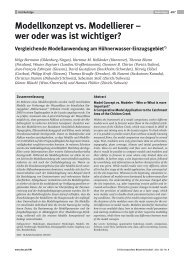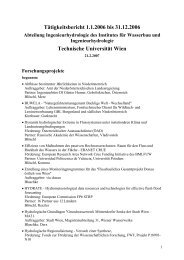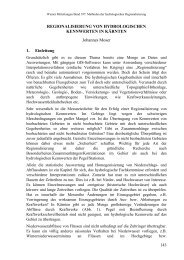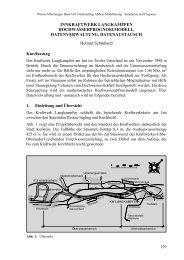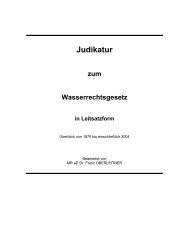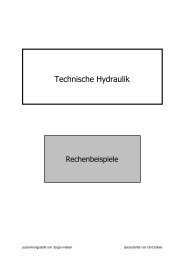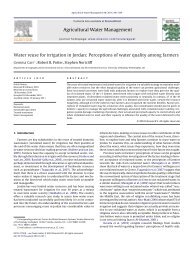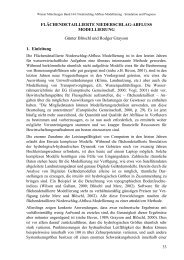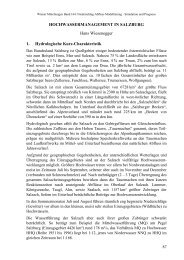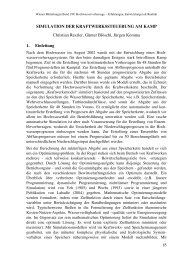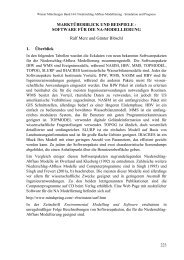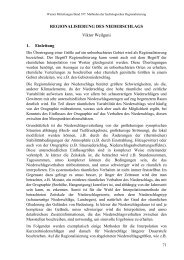Summary of Pattern Comparison and Concluding Remarks
Summary of Pattern Comparison and Concluding Remarks
Summary of Pattern Comparison and Concluding Remarks
Create successful ePaper yourself
Turn your PDF publications into a flip-book with our unique Google optimized e-Paper software.
360 R Grayson <strong>and</strong> G Blo¨ schl<br />
Walnut Gulch (Chapter 6) rainfall space-time variability was vastly more important<br />
than other controls, based on an analysis <strong>of</strong> rainfall data at the sub-hectare<br />
scale <strong>and</strong> a sensitivity analysis using the KINEROS model. For the very different<br />
climate <strong>of</strong> Reynolds Creek (Chapter 7) it was demonstrated that wind drift is by<br />
far the most important process affecting space-time patterns <strong>of</strong> snow water<br />
equivalent, by comparing observed snow water equivalent patterns with two<br />
simulated scenarios, with <strong>and</strong> without a representation <strong>of</strong> snow drift. In the<br />
humid climate <strong>of</strong> the Tarrawarra catchment (Chapter 9) saturated source area<br />
run<strong>of</strong>f was the dominant run<strong>of</strong>f mechanism as concluded from simple initial<br />
analyses <strong>of</strong> the observed TDR soil moisture patterns <strong>and</strong> later confirmed by<br />
Thales simulations. The simulations also confirmed that subsurface water movement<br />
changes abruptly in spring <strong>and</strong> autumn. During summer (dry), vertical<br />
water movement was dominant while in winter (wet), lateral water movement<br />
was dominant. Finally, a comparison <strong>of</strong> simulated <strong>and</strong> observed recharge/discharge<br />
patterns in the Prairie climate <strong>of</strong> Trochu (Chapter 12) indicated that<br />
recharge <strong>and</strong> discharge patterns were controlled by the coupling <strong>of</strong> the regional<br />
aquifer with the surface through the unsaturated zone, which dominated the local<br />
water budget. This finding was corroborated by a sensitivity study comparing<br />
scenarios with <strong>and</strong> without coupling to observed recharge/discharge patterns.<br />
The scenario without coupling could be made to match observed patterns only<br />
when unrealistically high values <strong>of</strong> recharge were assumed.<br />
<strong>Comparison</strong>s <strong>of</strong> simulated <strong>and</strong> observed patterns have also shed light on the<br />
nature <strong>of</strong> space-time variability <strong>of</strong> hydrologic variables that probably would not<br />
have been possible by simple visualisation <strong>of</strong> the data alone. For example, analyses<br />
<strong>of</strong> RADAR rainfall data in Chapter 4 suggested that the space-time variability<br />
<strong>of</strong> rainfall is characterised by dynamic scaling, i.e. the rainfall fluctuations<br />
in space <strong>and</strong> time can be represented by a power law when plotted against scale<br />
after appropriate renormalisation. This property was used for generating rainfall<br />
patterns by means <strong>of</strong> stochastic simulations (downscaling) that when compared<br />
to RADAR rainfall patterns, looked realistic. Analyses <strong>of</strong> remotely sensed<br />
(ESTAR) soil moisture patterns in Walnut Gulch (Chapter 6) indicated that,<br />
following a rainstorm, these patterns were organised but this organisation<br />
faded away after the storm, <strong>and</strong> the pattern became r<strong>and</strong>om. The authors suggested<br />
that this change-over is a reflection <strong>of</strong> the changing control on soil moisture<br />
<strong>of</strong> rainfall versus patterns <strong>of</strong> surface soil characteristics. A similar changeover<br />
in the variability <strong>of</strong> soil moisture, however this time on a seasonal basis, was<br />
identified at Tarrawarra (Chapter 9). Spatially organised patterns that were<br />
related to terrain occurred in winter while spatially r<strong>and</strong>om patterns occurred<br />
in summer. This change-over was identified by visual inspection <strong>of</strong> the TDR<br />
measurements <strong>and</strong> further explained by comparison with model results. In La<br />
Cuenca (Chapter 10) where infiltration excess <strong>and</strong> pipe flow were important<br />
run<strong>of</strong>f mechanisms, the type <strong>of</strong> spatial variability in soil hydraulic conductivity<br />
was inferred from a comparison <strong>of</strong> observed patterns <strong>of</strong> frequency <strong>of</strong> run<strong>of</strong>f<br />
occurrence with a number <strong>of</strong> scenarios with different types <strong>of</strong> soil variability<br />
represented. It was found that a combined deterministic (by soil type) <strong>and</strong>


